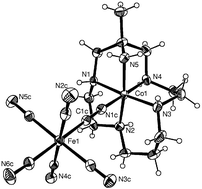The influence of cis/trans isomerism on the physical properties of a cyano-bridged dinuclear mixed valence complex†
Abstract
The

* Corresponding authors
a
Department of Chemistry, University of Queensland, Brisbane, 4072, Australia
E-mail:
bernhardt@chemistry.uq.edu.au
b Departament de Química Inorgànica, Universitat de Barcelona, Martí i Franqués 1-11, E-08028 Barcelona, Spain
The

 Please wait while we load your content...
Something went wrong. Try again?
Please wait while we load your content...
Something went wrong. Try again?
P. V. Bernhardt, B. P. Macpherson and M. Martinez, J. Chem. Soc., Dalton Trans., 2002, 1435 DOI: 10.1039/B110461F
To request permission to reproduce material from this article, please go to the Copyright Clearance Center request page.
If you are an author contributing to an RSC publication, you do not need to request permission provided correct acknowledgement is given.
If you are the author of this article, you do not need to request permission to reproduce figures and diagrams provided correct acknowledgement is given. If you want to reproduce the whole article in a third-party publication (excluding your thesis/dissertation for which permission is not required) please go to the Copyright Clearance Center request page.
Read more about how to correctly acknowledge RSC content.
 Fetching data from CrossRef.
Fetching data from CrossRef.
This may take some time to load.
Loading related content
